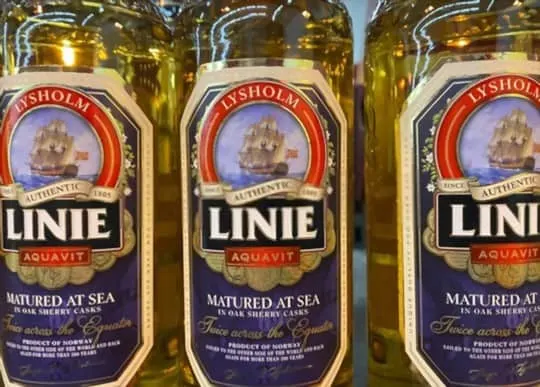Aquavit and Gin sit at the bar of spirits, each telling a tale soaked in history and flavor. We’re here to unravel this mystery. What sets them apart isn’t just their origin or the botanicals they flirt with.
Gin, a worldwide sweetheart, shines in its versatility. Cocktails love it. Aquavit, on the other hand, remains the Nordic gem, less known but with a depth that surprises.
Our own experience? We once mixed them up at a party. The result? A memorable night and a few confused taste buds.
In this chat, we’re pitting these two against each other. Not in a duel, but in a friendly handshake.
What is Aquavit?

This distilled drink is typically made from grain or potatoes and flavored with herbs and spices, most notably dill and caraway seeds.
The resulting taste profile can vary widely depending on how it is produced, but typically, aquavit has a strong herbal flavor with notes of citrus and licorice.
If you’re looking to explore new drinks that incorporate aromatic herbs and spices beyond your typical gin cocktail, then aquavit may be worth trying.
With its unique flavor profile and rich cultural history, this spirit is sure to appeal to those who appreciate bold tastes and distinctive blends of botanical ingredients.
What is Gin?

It has a minimum alcohol content of 37.
5% and can be distilled from various grains, such as wheat, rye or barley.
The origins of gin date back to the Middle Ages when it was originally used for medicinal purposes.
Today, gin is widely recognised as a popular ingredient in cocktails and enjoyed by many around the world.
One interesting fact about gin is that there are various types available on the market such as London Dry Gin, Old Tom Gin and Sloe Gin.
Each type has its unique characteristics that make them stand out from one another.
Additionally, some craft distilleries infuse their gins with botanicals other than juniper berries to create unique and exciting flavours.
Differences Between Aquavit and Gin

While both of them are clear, colorless spirits, they differ in terms of their production process, flavor profile, and cultural significance.
Aquavit is a Scandinavian spirit that is composed of potatoes or grains and infused with a unique blend of spices such as caraway or dill.
In contrast, Gin is a classic British spirit made by distilling botanicals such as juniper berries, coriander seeds, orris root in neutral alcohol.
It has an herbal taste with undertones of citrus and spice.
When it comes to their origin, aquavit has been known for centuries in Scandinavia whereas gin was first produced during the 17th century in England.
Moreover, the production method also varies as aquavit undergoes multiple distillations while gin may either be distilled or infused with botanicals.
In terms of usage, Aquavit is best enjoyed chilled or at room temperature as an after-dinner drink whereas gin can be used in several cocktails due to its versatility.
Moreover, aquavit has a stronger flavor profile compared to gin which allows it to stand out when consumed neat or in cocktails.
Overall, Aquavit and gin are distinctive spirits that cater to different palates and preferences.
Both spirits have their own unique production methods and cultural significance which make them a valuable addition to any bar.
Ultimately choosing between them depends on individual preference and the intended usage.
Origin and History
The roots and chronology of these popular spirits vary from region to region.
Both aquavit and gin have evolved significantly since their inception.
Aquavit was first distilled in the 15th century in Scandinavia, made from fermented grain or potato mash, flavoured with a variety of herbs and spices including caraway seeds, coriander and dill.
On the other hand, gin traces its origins back to the 17th century in England when juniper berries were added to neutral grain spirit to create a medicinal tonic intended to alleviate ailments such as stomach problems.
It’s noteworthy that while aquavit has always been associated with Nordic culture and traditions, gin has had an eventful rivalry between British and Dutch distillers over the centuries.
Both gin and aquavit have come a long way since their early beginnings.
Today, these spirits are celebrated not just for their cultural significance but also for their versatility in cocktails and drinks.
One interesting similarity is that both aquavit and gin can only be legally referred to as such if they meet certain minimum criteria for alcohol content, ingredient profile and production method as regulated by industry bodies like the EU Spirit Drink Regulations.
These regulations help maintain quality standards across manufacturers globally while preserving social responsibility in consumption practices.
Ingredients and Distillation Process
Aquavit and gin are two popular spirits with distinct ingredients and distillation processes.
Aquavit is a Scandinavian liquor made from potatoes or grain and flavoured with caraway or dill, among other herbs and spices.
The distillation process involves multiple filtering to ensure the smoothness of the final product.
In contrast, gin is made from a neutral spirit that is infused with botanicals, particularly juniper berries, through steeping or vapor infusion before distillation.
The type of still used can also affect the flavour profile of the gin.
Flavor Profiles
Aquavit and gin have distinctive flavor profiles that set them apart from each other.
Aquavit, a popular Scandinavian spirit, is flavored with caraway, dill, and other herbs.
It has a complex aroma with notes of anise and fennel.
On the other hand, gin is known for its predominant juniper taste and botanicals like coriander, citrus peel, and angelica root.
Gin also comes in various flavors like floral or spicy to add depth to cocktails.
These unique flavors make both spirits versatile for different cocktails and pairings.
Aquavit works well in savory cocktails such as Bloody Marys or as a substitute for whiskey in Old Fashioneds.
Gin, however, is perfect for refreshing drinks like Gin Fizz or Martinis.
Apart from their differences in flavor profiles and uses in cocktails, these spirits have cultural associations associated with them.
Aquavit is commonly served during special occasions like holidays or family celebrations in Nordic countries while gin has long been a favorite drink among British aristocrats.
Ultimately, the choice of which spirit to use depends on personal preference and cocktail requirements.
While gin remains a popular choice among mixologists globally because of its unique taste profile that lends well to various cocktail compositions; aquavit—although not so popular—is slowly gaining traction within cocktail circles due to its typically herbaceous notes.
Traditional Consumption Methods
Drinking spirits is one of the oldest and most traditional ways to indulge in alcohol beverages.
When it comes to consuming different types of alcohol, several factors play into the traditional methods that each drink prevails.
When it comes to aquavit and gin – both widely popular in Europe and America, people tend to prefer different liquid while indulging at traditional events or occasions.
In places where Aquavit is commonly consumed, it is often taken chilled and sipped slowly alongside pickled fish or other Nordic style dishes.
On the other hand, Gin is typically consumed with tonic water as a refreshing cocktail for those lively nights out on the town.
If you’re looking for something straightforward and easy to consume with a simple mixer, gin may be your best choice.
However, if you crave an exotic taste of dill, coriander seed, caraway seed or fennel infused liquor – aquavit should be your go-to drink.
Similarities Between Aquavit and Gin

Both are distilled spirits that involve steeping various botanical ingredients during the production process.
They have a unique taste profile and offer a range of options with varying flavors, including citrusy, spicy, herbal, or floral notes.
Additionally, both Aquavit and Gin are commonly used as cocktail bases due to their versatility in mixing with other spirits.
Furthermore, both Aquavit and Gin differ in their star ingredient, which gives each spirit its distinct taste.
Aquavit is primarily made from caraway seeds or dill, while gin is predominantly infused with juniper berries.
These differences strongly influence the overall flavor profiles of each drink.
In summary, although Aquavit and Gin have notable differences in their main ingredients, they share many similarities in terms of production process and versatility.
When choosing between the two spirits for cocktail-making purposes or personal enjoyment, it ultimately comes down to preferences in flavor profile.
Popular Brands of Aquavit and Gin
Aquavit and Gin are two popular spirits that have their unique characteristics.
Aquavit is a Scandinavian spirit made from potatoes or grains and flavored with caraway, dill, or aniseed.
Some popular brands of aquavit include Aalborg, Linie, and O.
P.
Anderson.
On the other hand, Gin is an English spirit typically made by distilling neutral grain alcohol with botanicals such as juniper berries, coriander, orris root, and citrus peel.
Some popular gin brands are Hendrick’s, Tanqueray, and Bombay Sapphire.
Each brand has its distinct flavor profile with varying levels of juniper and botanicals’ intensity.
For instance, Hendrick’s Gin is infused with rose petals and cucumber to give it a unique taste different from other gins’ commonly intense flavor profiles.
Similarly, Linie Aquavit has a smooth mouthfeel due to being aged in oak barrels on ships that circumnavigate the globe.
Choosing Between Aquavit and Gin: Factors to Consider
When it comes to choosing between aquavit and gin, different factors need consideration.
The type of flavor, whether spicy or botanical, is a critical aspect.
The versatility of each spirit in making various cocktails should also be considered.
With aquavit, caraway and fennel seeds provide its bold taste; on the other hand, botanicals like juniper berries make up the familiar gin flavor.
Moreover, the base alcohol used in making both spirits constitutes another factor.
While gin is mainly made from neutral grain spirits, potato-based alcohol constitutes aquavit’s base ingredient.
If one is looking for a more unique and unusual drink option, aquavit takes it away over gin with its distinct flavor profile.
One other thing to consider when selecting between these two spirits is storage conditions.
Aquavit can spoil if not refrigerated after opening while gin can last long without refrigeration.
Ultimately, the choice between these two spirits boils down to individual preference based on flavor profile and usage requirements such as cocktail making versus drinking straight up.
Conclusion
This comparison between aquavit and gin brings interesting insights to the world of spirits.
Both the beverages offer unique taste profiles and are popular in their respective regions.
While gin is widely consumed globally, aquavit is a traditional drink enjoyed in Scandinavian countries.
However, both drinks have their fans worldwide.
One significant difference lies in the herbal composition; aquavit has a distinct taste of caraway seeds, whereas gin boasts of juniper berries.
So, choosing between these two comes down to personal preference – whether one likes the bold flavor with hints of citrus offered by gin or prefers aquavit’s warm spicy notes with a hint of sweetness.
Ultimately, there isn’t a better option as both drinks bring their unique aromas and flavors to elevate your drinking experience.

Leave a comment